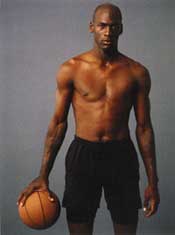Michael Jordan: Driving Force in the Paint and in the Marketplace

Cibachrome print, 1991 / National Portrait
Gallery, Smithsonian Institution; © Annie
Leibovitz
Few individuals have had such effect on their sport as Michael Jordan did his. Mark Spitz brought about a renewed interest in swimming after his seven-gold medal performance in the 1972 Munich Olympics, and Tiger Woods, the first African American to win a major tournament in golf, introduced that sport to an entire generation of kids worldwide. Mark McGuire and Barry Bonds each revitalized baseball with their towering numbers of home runs in the 1990s, only to succumb to steroid-use allegations in the early 2000s.
Michael Jordan, however, increased the fan base and the viewership of the National Basketball Association. Sure, Larry Bird and Magic Johnson’s classic Celtics-versus-Lakers confrontations preceded the Jordan era and dovetailed into the great period of the Chicago Bulls’ dominance of the game. But Michael Jordan put basketball into the forefront of American athletic culture. It was the hang-time. It was the ball-handling. It was Jordan’s sheer athleticism that captivated the world. One of the iconic moments of his game was the drive toward the basket, bursting past whatever futile defense was thrown at him—maneuvering the ball left to right, right to left—all the while having his tongue flicking out from his mouth as if he were caught in the act of thinking through his penetration strategy.
Beyond the court, though, Jordan rode the vehicle of basketball to the heights of early globalization. Walter La Feber discusses the phenomenon in his book Michael Jordan and the New Global Capitalism:
The magic words were “packaging” and “synergy” (that is, the cooperative working together of many more goods to make much larger profits than the goods could make alone). Michael Jordan stood apart as a global symbol of synergy’s magic. He and his agent, David Falk, had begun in the 1990s to use a global communications company for selling not just one of the products Jordan endorsed, but a bundle of them linked together. Thus Jordan could suggest that his fans watch the ‘Space Jam’ film while sitting in their Hanes underwear, eating Big Macs, washing those down with Gatorade, and preparing to buy Jordan’s videos over their Jordan-endorsed cell phone.
Michael Jordan in the 1990s, it seems, was capitalism’s greatest voice. Jordan’s performance in world trade was only outdistanced by his performance on the basketball court, though, and he is widely regarded as the greatest player of all time. With an NCAA championship (with the North Carolina Tar Heels in 1982), as well as multiple NBA and Olympic championships under his belt, Jordan also has the distinction of holding the NBA regular season scoring average (30.1) among his many, many other superlatives.
- Warren Perry, Catalog of American Portraits, National Portrait Gallery
Cited: Walter La Feber, Michael Jordan and the New Global Capitalism (New York: W. W. Norton, 1999)
On Thursday, February 10, NPG historian David Ward will discuss Michael Jordan’s career during a Face-to-Face Gallery Talk at 6:00 p.m. Admission is free; meet in the F Street lobby of the Donald W. Reynolds Center a few minutes before the talk begins.